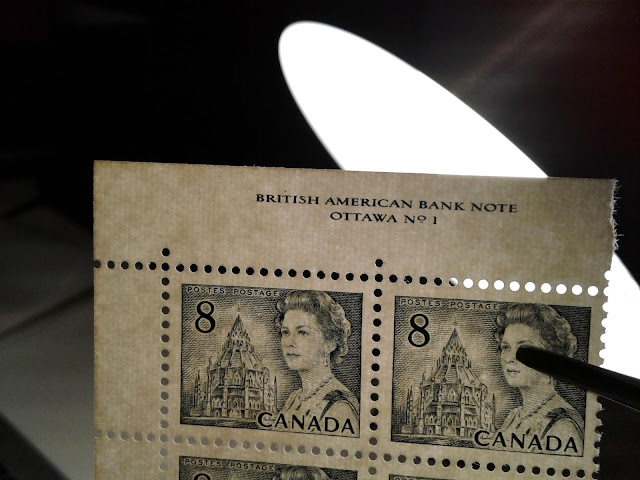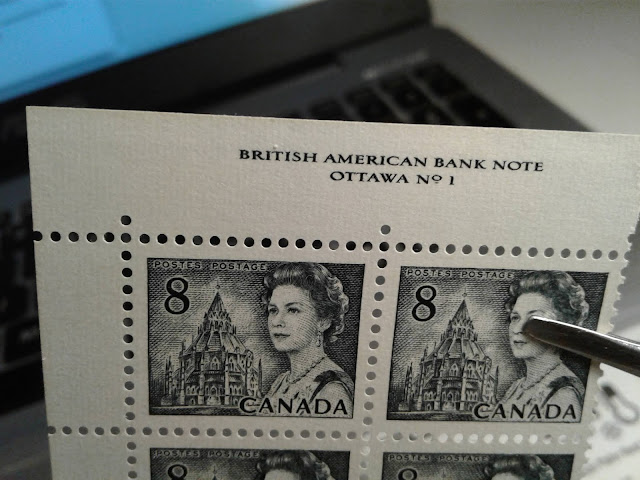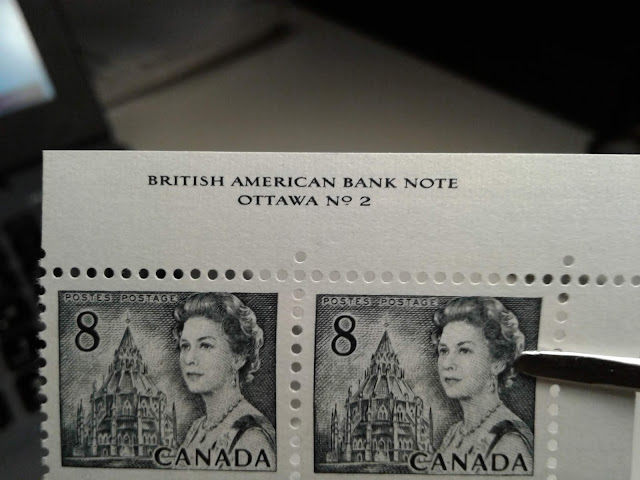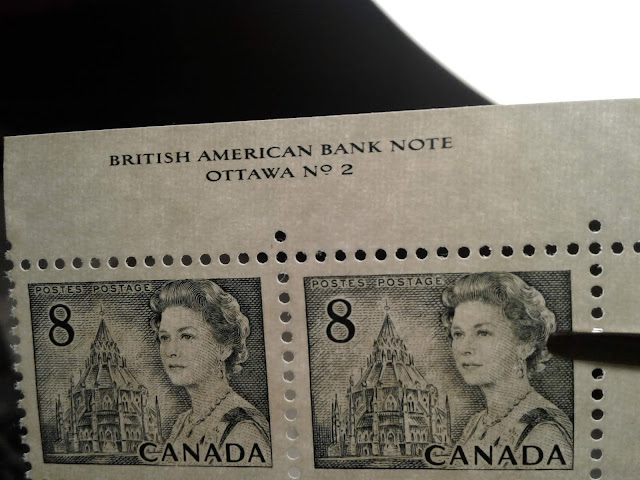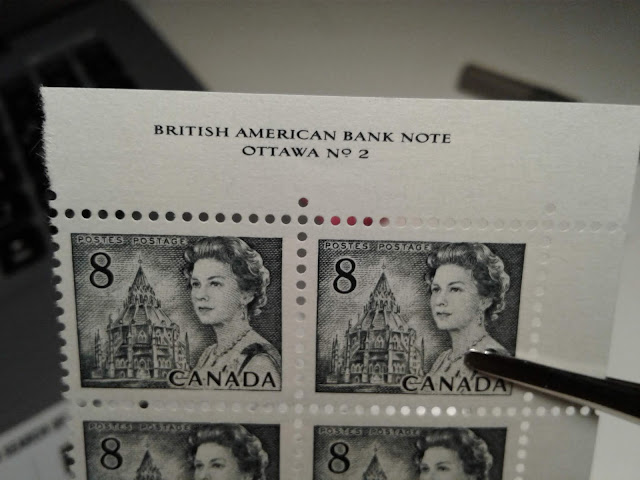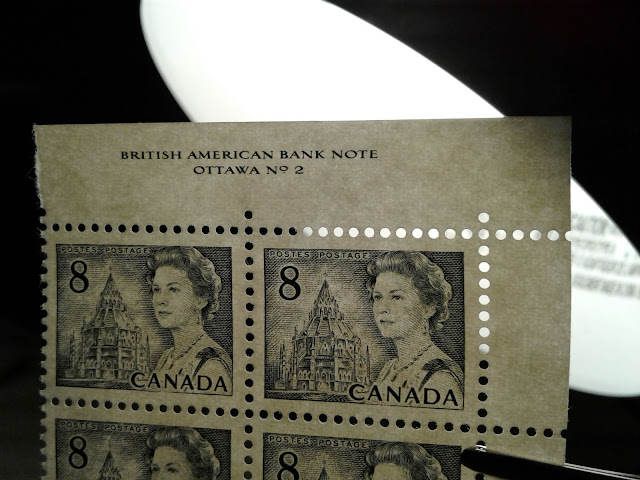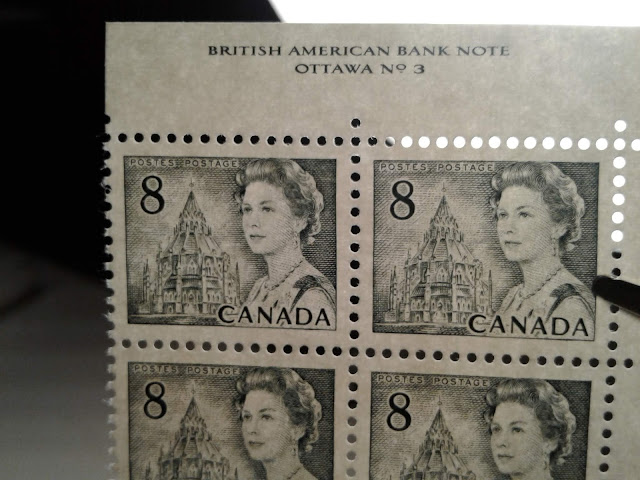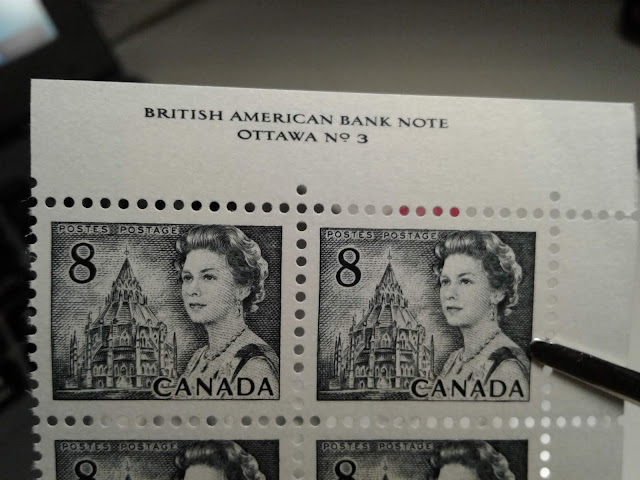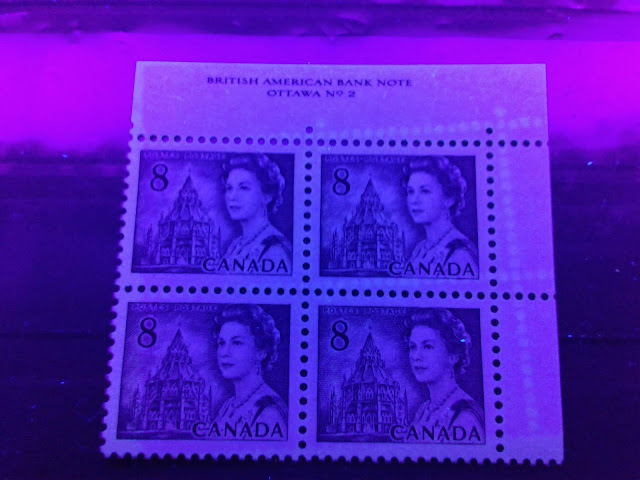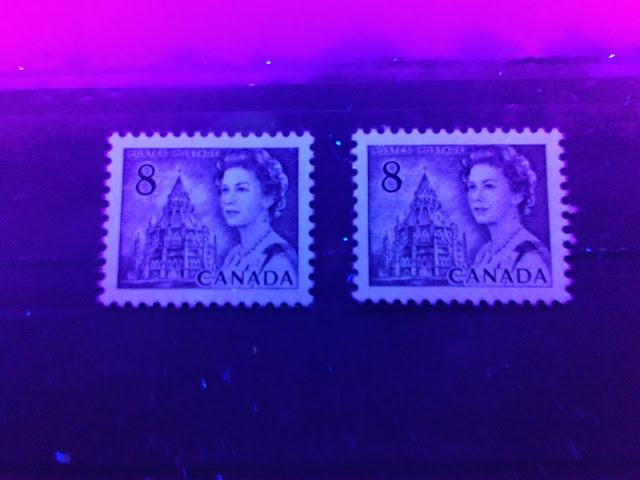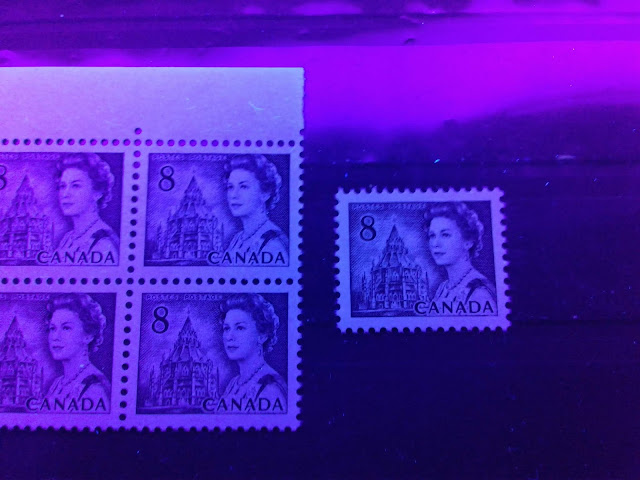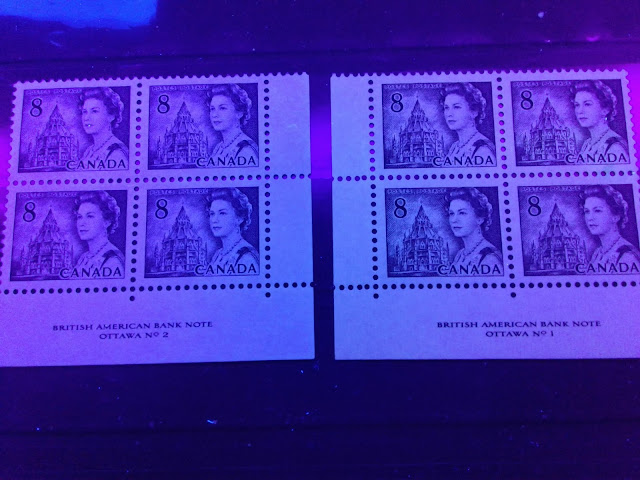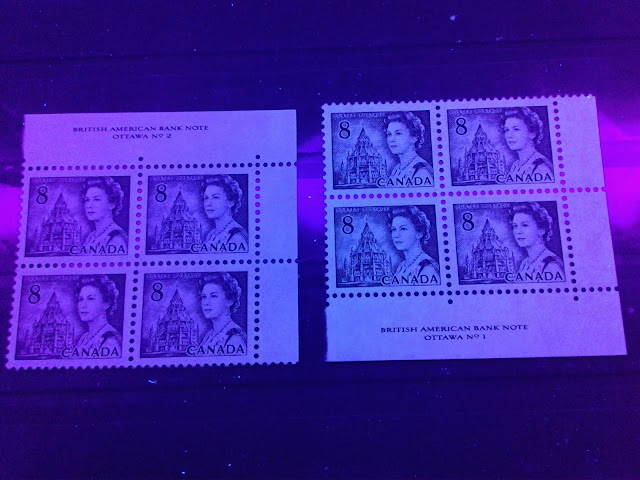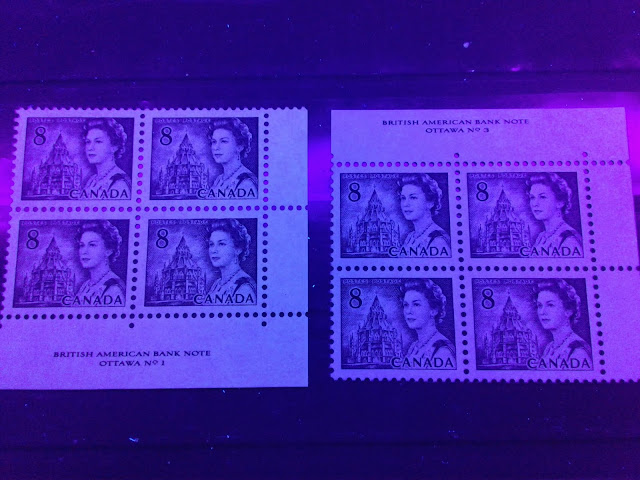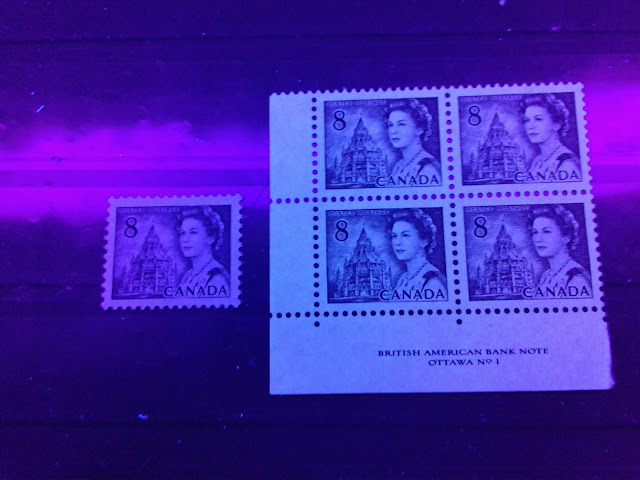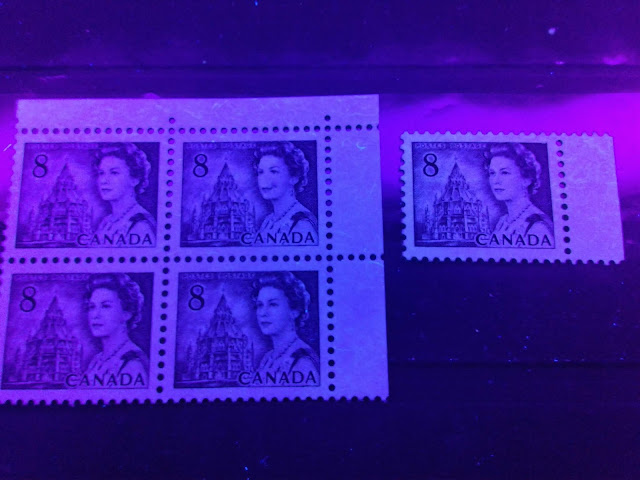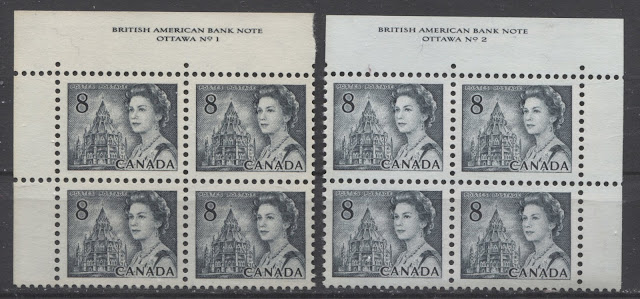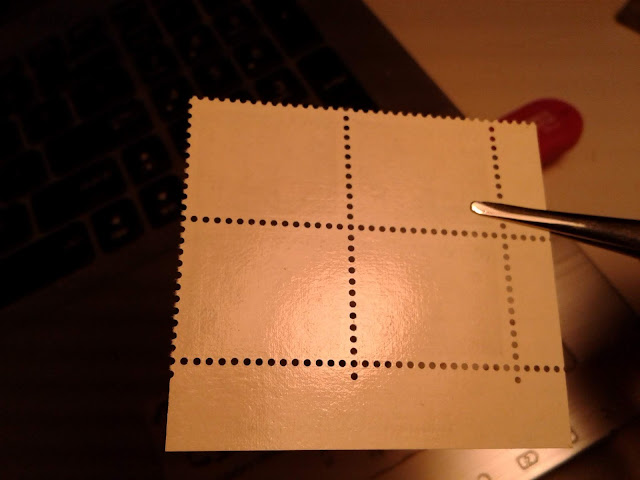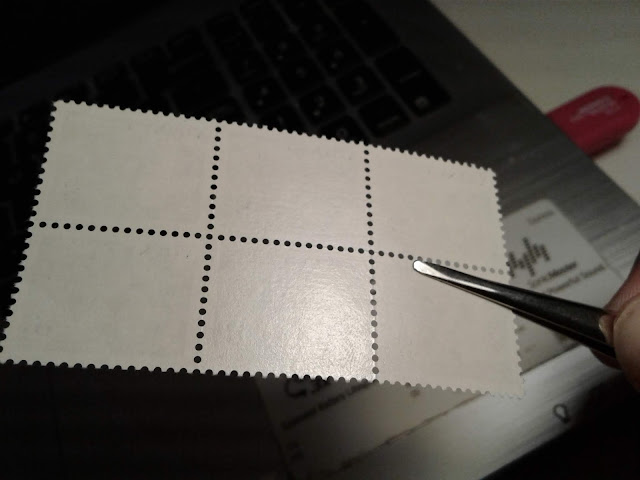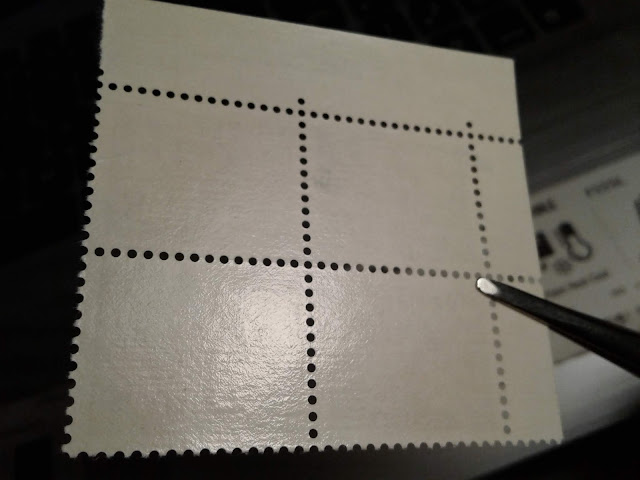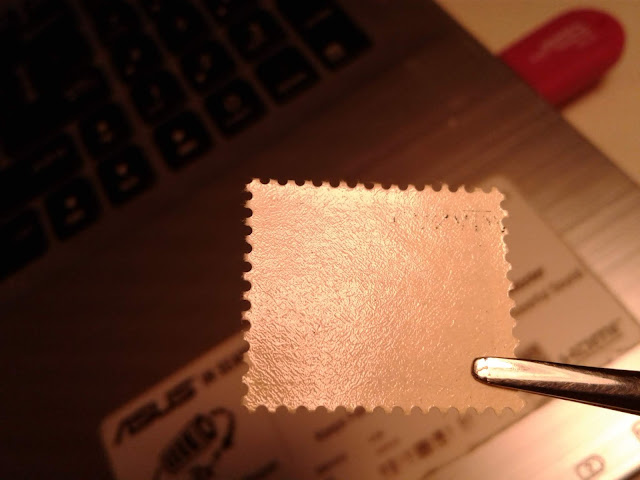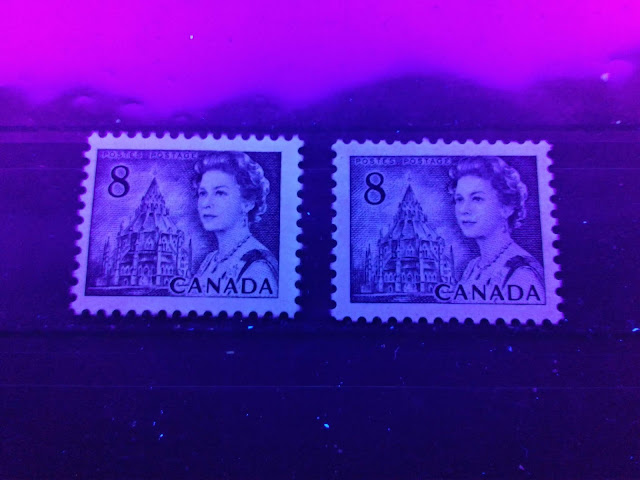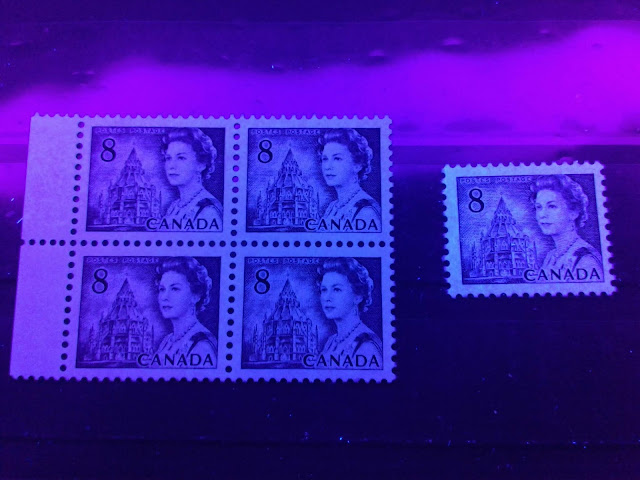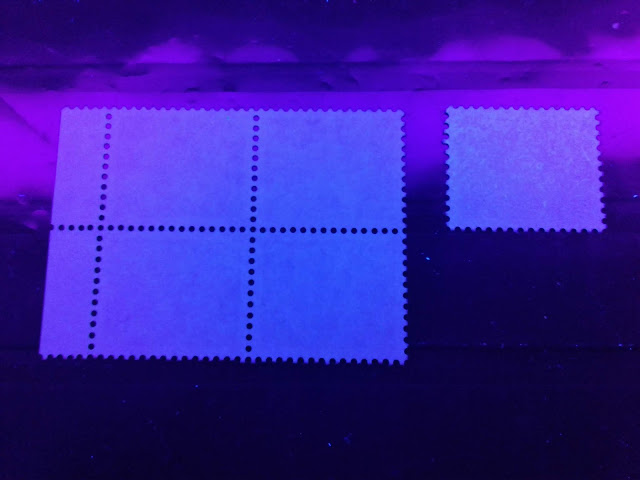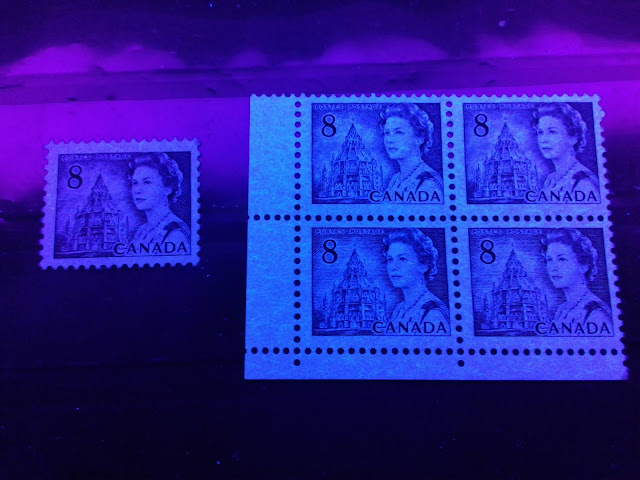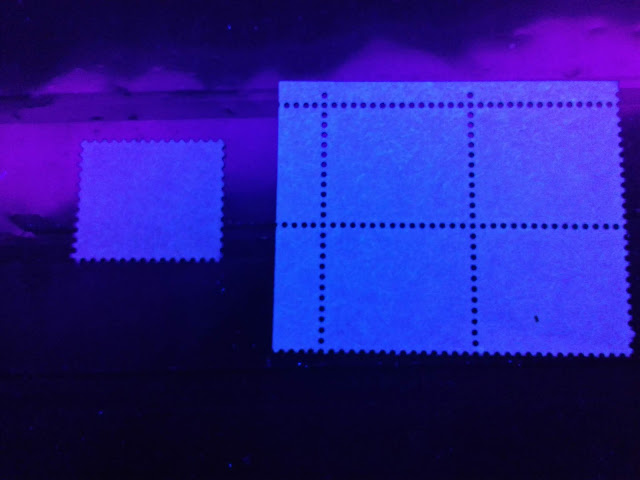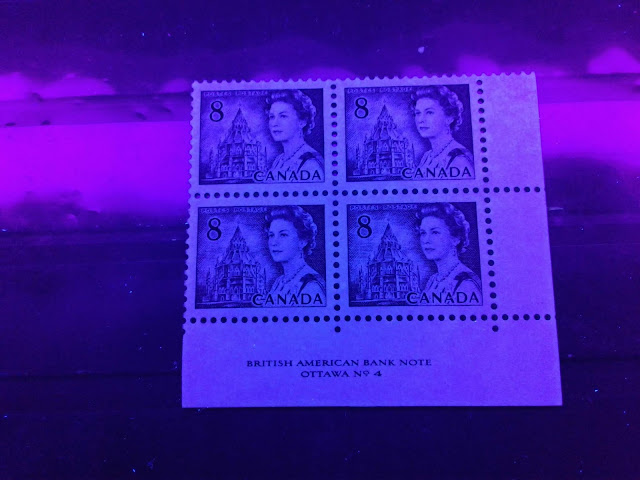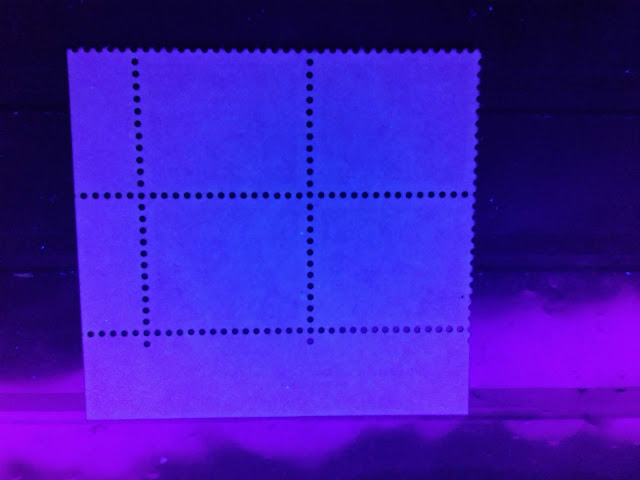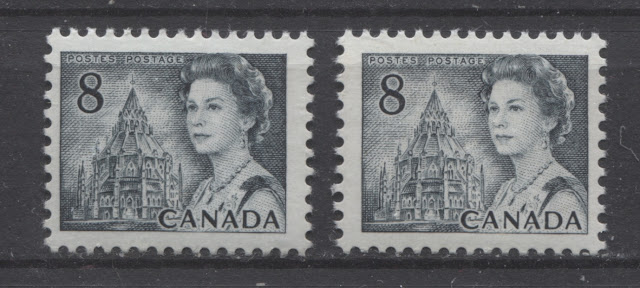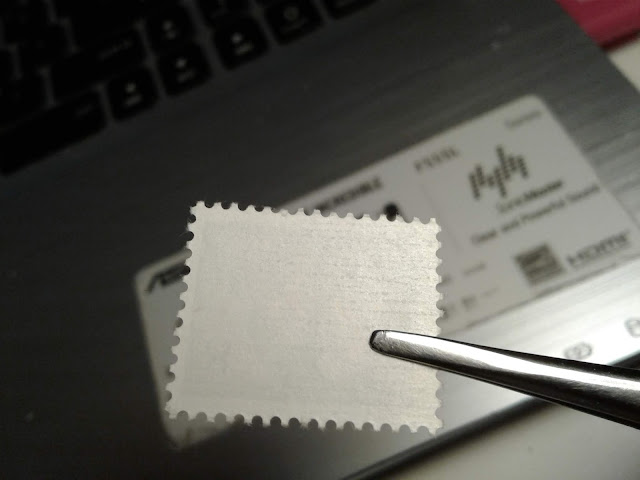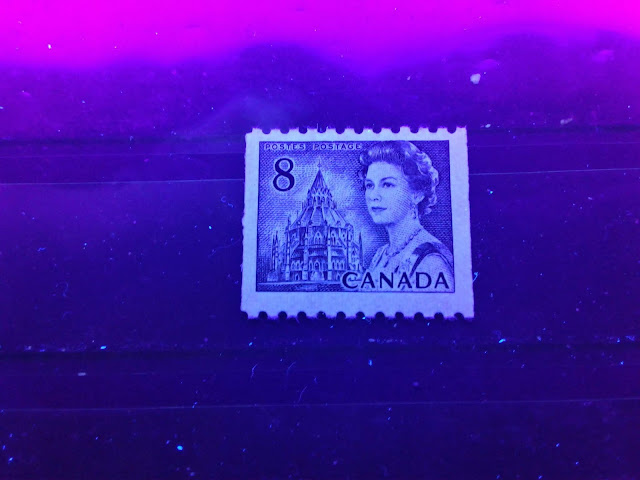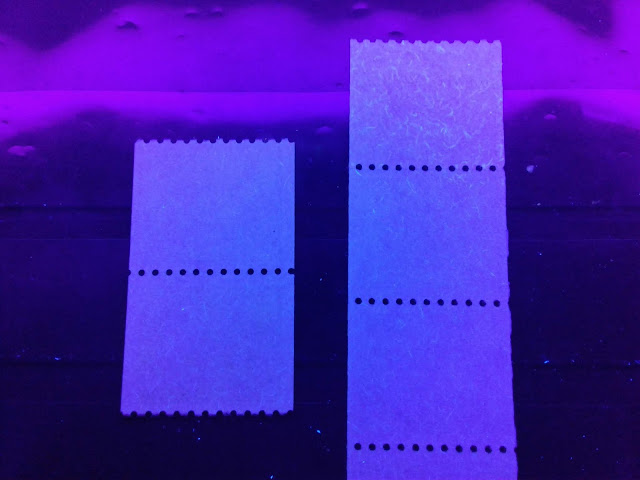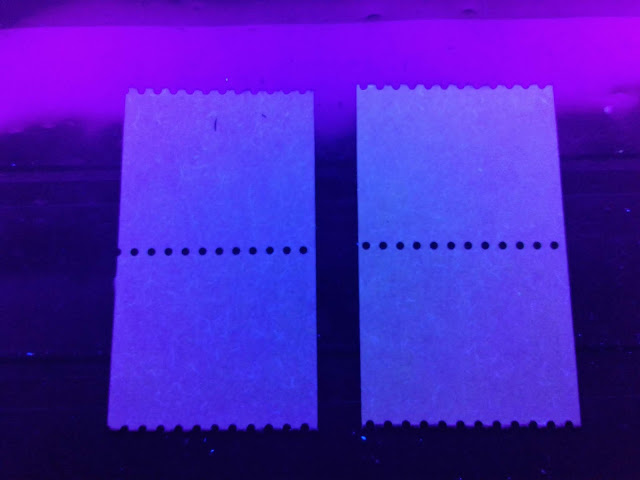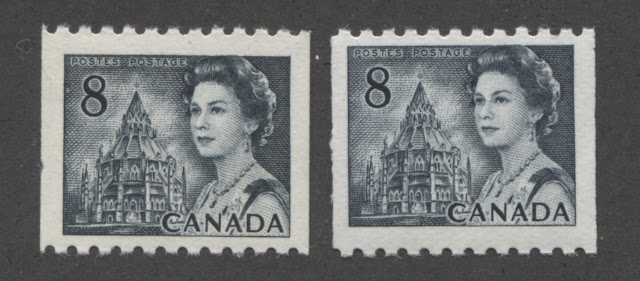Today, I begin a series of four posts to tackle, what is the last of the low value stamps in the series, and one of the most complicated: the 8c slate Parliamentary Library design. This stamp was released after the third postage rate increase since 1968, and was released on December 30, 1971. It is the only stamp produced by the BABN in which both the sheet stamps and the booklet stamps are found with both dextrose and PVA gums and with both Winnipeg and Ottawa Tagging.
Today's post will explore the untagged sheet stamps and the untagged coil stamps. Next week, I will look at the Winnipeg tagged sheet stamps. The following week, the General Ottawa Tagged sheet and coil stamps, and then the following week after that, I will look at the booklet stamps. This last post will repeat much of the same material as the earlier posts about the 1c, and 6c booklet stamps, as the 8c booklet stamps came from the same booklets as these other stamps. The 8c and 7c denominations were the only first class rate denominations that were not issued in large booklets containing only that value.
In addition to the large number of paper, shade, gum, and tagging varieties known on these stamps, Unitrade notes that there are over 75 constant cylinder varieties known on this design. Thus, there are a massive number of collectible stamps of this issue if these varieties are sought for each individual paper, shade, gum or tagging variety. Most of these were discovered by the late Mike Painter, a prominent Centennial specialist who lived in Vancouver. I well remember Mike from the days when I worked at Weeda Stamps Ltd. in Vancouver. Back then we had a massive bin containing used Centennial killoware, which we sold for $6.95 a pound. Mike would come in every week and buy a pound of mix to go through. This was likely the source from which he discovered most of his varieties I suspect.
The remainder of this post will now go over the untagged stamps in detail.
The Untagged Sheet Stamps With Dextrose Gum - Unitrade #544 and 544i
Paper Characteristics Other Than Fluorescence
The pictures below show each type of paper when viewed full-on and against back-lighting:
Here is the strongly ribbed cream paper when viewed against back-light. Note the very strong mesh pattern in the paper.
Here is the same block in normal light. Again, you can see the vertical ribbing very clearly in the upper selvage tab of the block.
Here is the moderate ribbed paper in normal light. As you can see, the ribbing is much less obvious. Here you have to look at the upper part of the selvage tab near the inscription to see it.
Here is the same block viewed against back-lighting. The mesh pattern is still clearly visible, but is not nearly as strong as on the first type of paper above.
Here is a block on the weakly ribbed paper. As you can see, no clear ribbing is visible in normal light.
Here is a plate 3 block on the smooth paper, as seen against back-lighting. Note the complete absence of any clear mesh pattern.
Here is the same block in normal light. Note how the printing surface appears completely smooth.
Paper Fluorescence
Unitrade lists this stamp as existing only on dull fluorescent paper as well as low fluorescent paper with fluorescent fibres. However, this is not correct. In addition to several types of dull fluorescent paper, there are several types of low fluorescent paper, as well as a non-fluorescent paper:
These stamps are printed on the dull fluorescent pale blue grey paper. The only difference between the above two stamps is that the one on the left contains very few low fluorescent fibres in the paper, while the one on the right does not contain any visible fluorescent fibres.
The block on the left is printed on dull fluorescent pale grey paper with very few low, medium and high fluorescent fibres. The stamp on the right is printed on dull fluorescent greyish white paper with very few low fluorescent fibres. You can just make out the high fluorescent fibre in the selvage of the block just above the Queen's head. Overall, the fluorescence of the stamp reads as being slightly brighter than the block because the concentration of low fluorescent fibres is a greater in the stamp than the block.
The block on the left is the same paper as the single stamp on the right in the previous picture. The block on the right is the dull fluorescent cream paper.
The block on the left is the dull fluorescent pale grey paper, while the block on the right is dull fluorescent ivory.
The block on the left is dull fluorescent brownish grey, while the block on the right is dull fluorescent greyish.
I have identified two distinct shades on this stamp: a deep slate, which seems to dominate on most of the plate 1 printings and a bluer, less deep slate, which is found on the plate 2 and plate 3 printings. The scan below shows these two shades clearly.
The deep slate is shown on the left block, while the less intense, more bluish slate is shown on the right block. Neither colour is significantly impacted by exposure to UV light, so that the inks used to print these stamps are non-transformative.
Gum
Like the other BABN stamps with dextrose gum, I have found all four types of dextrose gum:
The pictures below show each of these types.
The high gloss gum.
The semi-gloss gum.
The semi-smooth gum.
The crackly gum.
Perforation
These stamps were comb perforated 12.5 x 12. No variation has been found in the gauge of the perforation. The sheets were fully perforated through in the horizontal direction, so that the right and left selvage tabs are fully perforated through horizontally. The top and bottom margins each contain one extension hole above and below the top and bottom rows of horizontal perforations, but are otherwise imperforate.
Plate Flaws
There are no documented major plate flaws on this stamp. The extra spire flaw that is listed in Unitrade comes from plate 4, and will be dealt with on the PVA gum stamps. There are, of course, the 75+ constant cylinder flaws that can be collected. I do not have any of these to illustrate at this point, but will include scans of those that I encounter in the future.
Bringing it All Together
I have identified 4 paper types, 14 levels of fluorescence, 4 types of gum, and 2 shades, though it is fairly clear that not all varieties exist in combination with the others. However, if all the varieties can be found in combination with the others then there could be as many as: 4 x 14 x 4 x 2 = 448 collectible stamps, ignoring the cylinder flaws. Given that there were 3 plates used to do the printing, this means that there could be as many as 5,376 plate blocks and 16,128 collectible blank corner blocks. The actual number of identifiable varieties though is likely to be much less than this, though how much less is a matter for an all-encompassing study of this value.
The Untagged Sheet Stamps With PVA Gum - Unitrade #544ii, 544iii and 544iv
Paper Characteristics Other Than Fluorescence
Paper Fluorescence
Unitrade lists the PVA gum untagged stamps as existing only on low fluorescent and high fluorescent papers, which is confusing, as both of these papers contain fluorescent fibres, so they should be denoted as LF-fl and HF-fl rather than LF and HF. However, I have found variations of dull fluorescent paper that contain no fluorescent fibres as well as medium fluorescent paper containing fluorescent fibres.
The varieties of fluorescence that I have found include the following:
The dull fluorescent ivory paper is shown on the left while the dull fluorescent pale blue grey paper is shown on the right. Neither paper has any visible fluorescent fibres. The paper is dull when compared to other known dull fluorescent papers, and does not merely appear this way on its own.
The block on the left is printed on low fluorescent pale blue grey paper with a sparse concentration of low fluorescent fibres. The stamp on the right is printed on low fluorescent bluish white with low density concentrations of low fluorescent and medium fluorescent fibres, as well as a sparse concentration of brownish woodpulp fibres. This paper appears medium fluorescent to high fluorescent overall. The paper of the block on the left appears low fluorescent overall, but it is different from the normal low fluorescent paper seen on most blocks from plate 4.
The back photos of the above will hopefully provide some further clarity as to the appearance of the papers:
The fluorescent fibres on the low fluorescent paper are not obvious, but they are visible without a loupe, whereas on the normal fluorescent paper, you need a loupe to see them, as they are usually concealed by the overall fluorescent glow of the paper. The fluorescent fibres on the right stamp are obvious however, and show up in this picture as a mottling of the colour on the back.
The stamp on the left is printed on dull fluorescent greyish white paper with a low density concentration of low fluorescent fibres and sparse concentrations of medium fluorescent fibres and brownish woodpulp fibres. This reads as medium fluorescent overall. The block on the right is printed on dull fluorescent bluish white paper containing low density concentrations of low, medium and high fluorescent fibres. The paper reads as high fluorescent overall.
Here are these same stamps as seen from the back:
As you can see, the fluorescent fibres are obvious on both varieties as mottling of the colour under UV light.
This is the common low fluorescent paper from plate 4. It has a light violet grey colour under UV and on its own it looks almost dull. But when compared to other dull fluorescent papers, it clearly stands out as low fluorescent. It contains a low density concentration of low fluorescent fibres. However, the fibres are concealed by the overall glow of the paper, and you generally need to examine the paper up close with a 10x loupe to see them.
Here is the appearance of this block as seen from the back:
Shades
On these stamps I have also found two shades: a bluish slate that is similar to the bluish slate on the dex. gum stamps and a pure, less bluish slate, as shown below:
The more bluish slate is shown on the left, and the less bluish one on the right.
Gum
I have found two types of PVA gum on these stamps:
Perforation
The perforation used for these stamps is comb 12.5 x 12 as before, with the same perforation layout as in regards to the sheet margins. I have not yet found any significant variation in the gauge, or the configuration of the perforation.
Plate Flaws
There is one very scarce and well known flaw on the PVA gum stamps that is thought to come from several positions of plate 4: the extra spire flaw.
The flaw consists of a large jagged line to the left of the left spire of the library building. It is a highly sought after and valuable variety, listing for between $100 and $150 in Unitrade, depending on whether the stamp is mint or used.
The 75+ constant roller flaws that were mentioned on the dextrose gum stamps are also found on these stamps as well, though it is not clear whether all 75 can be found with each of plates 4, 5, 6 and 7, which were the plates used to print the PVA gum stamps. All of the untagged stamps appear to have come only from plate 4 however.
Bringing it All Together
I have identified four paper types, 7 levels of fluorescence, 2 types of gum and 2 shades. It would appear that the scarce streaky gum is probably unique to one printing, so for all the other varieties, there is likely only one type of PVA gum. If all varieties exist in combination with each other, then there could be as many as: 4 x 7 x 2 + 1= 57 collectible stamps, 57 x 4 = 228 plate 4 blocks and 684 blank corner blocks that can be collected, if we completely ignore the plate and roller flaws that can also be found. If those are factored in, then the potential scope of a specialized collection of these stamps increases dramatically.
The Untagged Coil Stamps - Unitrade #550, 550a, 550i and 550ii
Paper Characteristics Other Than Fluorescence
Ignoring fluorescence, I have found the following types of paper on these coil stamps:
Paper Fluorescence
Unitrade lists this coil as existing on dull fluorescent paper, dull fluorescent horizontal ribbed paper and fluorescent paper. In reality, there are at least four different varieties of the fluorescent paper. The fluorescent paper (F) is a designation that I have always found confusing, given that Unitrade also refers to low fluorescent and medium fluorescent. I have always understood it to be a level of overall brightness somewhere in between low fluorescent and medium fluorescent. I do not have any examples of the dull fluorescent smooth paper, or the horizontal ribbed paper. However, I do have an unlisted dull fluorescent paper that is clearly vertically ribbed. It is a very scarce stamp, judging from the fact that I possess only a single example.
The variations I have found include:
The dull fluorescent blue grey, vertical ribbed paper. Ifyou look carefully at the bottom margin of the above stamp and relax your gaze, you may just be able to make out the vertical ribbing in the paper.
The dull fluorescent greyish paper with a very sparse concentration of low fluorescent and medium fluorescent fibres is shown in the pair on the left. The strip on the right is the dull fluorescent greyish white paper with a sparse concentration of low fluorescent fibres, a very sparse concentration of medium fluorescent fibres, and very few high fluorescent fibres.
These papers are very similar, but the main difference is in the overall appearance. The pair on the right looks ivory in colour, whereas the one on the left looks more blue grey. The pair on the left is the dull fluorescent blue grey paper with sparse concentrations of low fluorescent and medium fluorescent fibres, and a very sparse concentration of high fluorescent fibres. The pair on the right is the dull fluorescent ivory paper with a sparse concentration of low fluorescent fibres, a very sparse concentration of medium fluorescent fibres and very few high fluorescent fibres.
Shades
As with the sheet stamps, I have found two similar, but slightly different shades: a deep slate, and a deep slate that has a more bluish undertone, as shown below:
Gum
I have found two types of gum on these coil stamps:
Perforation
According to Unitrade, these coils are perforated 10 exactly in the horizontal direction. The coils were printed by the CBN, which at the time only had access to line perforating machines. These coils are also known imperforate, though Unitrade does not specify what type of paper the imperforate pairs occur on. I would assume that they can be found with most of the paper and gum types.
Plate Flaws
There are no major plate flaws documented on the 8c coil stamps, though I would definitely keep an eye out for an extra spire variety on this stamp as well as the plate 4 sheet stamps.
Spacing Varieties
These coils were also issued in rolls of 100 that were joined together and scored in between the rolls, so that they could be snapped apart at the post office. Consequently, there are no repair paste-ups, no start strips and no end strips. However, jump strips, wide spacing strips and narrow spacing strips can all be collected on these. Unfortunately, I do not have any examples to illustrate here, but I will add scans as they become available.
Bringing it All Together
I have identified three paper types, five levels of fluorescence, two types of gum and two shades. The vertical ribbed paper seems to exist with only one level of fluorescence and type of gum. However, the other varieties may well exist in combination with one another. Thus there could be as many as: 2 x 5 x 2 x 2 + 1 = 41 different single collectible stamps and as many jump strips, narrow spacing strips and wide spacing strips that can be collected.
This concludes my first part of the exploration of the 8c Parilamentary Library stamp. Next week, I will examine the Winnipeg tagged sheet stamps.
Today's post will explore the untagged sheet stamps and the untagged coil stamps. Next week, I will look at the Winnipeg tagged sheet stamps. The following week, the General Ottawa Tagged sheet and coil stamps, and then the following week after that, I will look at the booklet stamps. This last post will repeat much of the same material as the earlier posts about the 1c, and 6c booklet stamps, as the 8c booklet stamps came from the same booklets as these other stamps. The 8c and 7c denominations were the only first class rate denominations that were not issued in large booklets containing only that value.
In addition to the large number of paper, shade, gum, and tagging varieties known on these stamps, Unitrade notes that there are over 75 constant cylinder varieties known on this design. Thus, there are a massive number of collectible stamps of this issue if these varieties are sought for each individual paper, shade, gum or tagging variety. Most of these were discovered by the late Mike Painter, a prominent Centennial specialist who lived in Vancouver. I well remember Mike from the days when I worked at Weeda Stamps Ltd. in Vancouver. Back then we had a massive bin containing used Centennial killoware, which we sold for $6.95 a pound. Mike would come in every week and buy a pound of mix to go through. This was likely the source from which he discovered most of his varieties I suspect.
The remainder of this post will now go over the untagged stamps in detail.
The Untagged Sheet Stamps With Dextrose Gum - Unitrade #544 and 544i
Paper Characteristics Other Than Fluorescence
Unitrade does not make any mention at all of characteristics in the paper used to print these stamps other than the fluorescence. This is odd, because there are marked physical differences between the various types of paper that were used for the various printings of these stamps. I have specifically identified four different types of paper, ignoring the fluorescence qualities. It does appear that each type is associated with only one or a few levels of fluorescence, though I must emphasize that my sample of stamps and blocks with which I have had to work is extremely small in relation to the total number of stamps printed. Therefore, it is entirely possible that more types of paper may exist, and each type may exist with several different levels of fluorescence and not just the ones that I have identified here.
The four types of paper can best be described as follows:
- A soft, cream coloured horizontal wove paper that shows very strong vertical ribbing on the printing surface. This ribbing is so obvious that it can be seen without having to tilt the stamps and view them obliquely. Under magnification, a light surface coating is evident, that prevents any loose paper fibres from accumulating on the printing surface. When viewed against strong back lighting, a very prominent vertical mesh pattern is visible in the paper. This paper type seems to be limited to plate 1 printings on dull fluorescent cream paper, dull fluorescent ivory paper, dull fluorescent brownish grey and low fluorescent cream papers.
- A firmer, whiter horizontal wove paper that often has a slightly bluish tint from the slate ink used to print the stamps. This paper shows weak vertical ribbing on the surface, but it is less prominent than the first type of paper. This paper is also lightly coated. When viewed against strong backlighting, a clear, but less prominent vertical mesh pattern is visible in the paper. This paper seems to be confined to plate 2 printings , and has been specifically identified as occurring on non-fluorescent grey blue paper, dull fluorescent blue grey paper. However, several varieties of fluorescence that were not identifiable as to plate are found on this paper as well.
- A firm, light cream horizontal wove paper that has a smooth appearance on the surface. If you tilt blocks on this paper and view them at an angle to a strong light source, you can just make out very light vertical ribbing on the surface. However, it is not visible unless you view the stamps in this way, and you would probably not see it on individual stamps. This paper is lightly coated also, and when held up to a strong back light, a faint vertical mesh pattern is visible in the paper. This paper seems to also be limited to plate 2 printings, and has been specifically identified to occur on dull fluorescent greyish white paper with very few low fluorescent fibres, and dull fluorescent greyish paper. However, several varieties of fluorescence that were not identifiable as to plate are found on this paper as well.
- A firm, light cream coloured horizontal wove paper that has a completely smooth appearance, even when viewed at an angle to the light. This paper is lightly coated, and when held up to strong back lighting, no clear mesh pattern is visible. This paper type was only found on plate 3 printings giving a dull fluorescent greyish colour under UV light.
The pictures below show each type of paper when viewed full-on and against back-lighting:
Here is the strongly ribbed cream paper when viewed against back-light. Note the very strong mesh pattern in the paper.
Here is the same block in normal light. Again, you can see the vertical ribbing very clearly in the upper selvage tab of the block.
Here is the moderate ribbed paper in normal light. As you can see, the ribbing is much less obvious. Here you have to look at the upper part of the selvage tab near the inscription to see it.
Here is the same block viewed against back-lighting. The mesh pattern is still clearly visible, but is not nearly as strong as on the first type of paper above.
Here is a block on the weakly ribbed paper. As you can see, no clear ribbing is visible in normal light.
Here is the same block viewed against back-lighting. If you look in the selvage tabs, you can make out a faint vertical mesh. However, it is not anywhere near as strong as it is on either of the first two paper types.
Here is a plate 3 block on the smooth paper, as seen against back-lighting. Note the complete absence of any clear mesh pattern.
Here is the same block in normal light. Note how the printing surface appears completely smooth.
Paper Fluorescence
Unitrade lists this stamp as existing only on dull fluorescent paper as well as low fluorescent paper with fluorescent fibres. However, this is not correct. In addition to several types of dull fluorescent paper, there are several types of low fluorescent paper, as well as a non-fluorescent paper:
- Non-fluorescent grey blue. The sole block that I have is from plate 2.
- Dull fluorescent pale blue grey with very few low fluorescent fibres.
- Dull fluorescent pale bluish grey.
- Dull fluorescent pale grey with very few low, medium and high fluorescent fibres.
- Dull fluorescent greyish white with very few low fluorescent fibres. All three blocks that I have are from plate 2.
- Dull fluorescent cream. All blocks that I have of this paper are plate 1.
- Dull fluorescent pale grey. The blocks I have examined on this paper are plates 2 and 3.
- Dull fluorescent ivory. All the blocks I have examined are plate 1.
- Dull fluorescent brownish grey. All of the blocks I have examined are plate 1.
- Dull fluorescent greyish. All the blocks I have examined are plate 3.
- Dull fluorescent blue grey.
- Low fluorescent cream. The sole block in my possession is from plate 1.
- Dull fluorescent greyish white with sparse concentrations of low and medium fluorescent fibres and very few high fluorescent fibres. The only block in my possession is blank.
- Dull fluorescent bluish white with a sparse concentration of low fluorescent fibres and very few medium and high fluorescent fibres.
Papers 1 through 11 are what Unitrade would list as dull fluorescent, though paper 1 is clearly much duller than mere DF, so is an unlisted variety. Papers 11-14 are variations of what Unitrade would list as LF-fl paper.
The pictures below show each of the above varieties of fluorescence:
This is the non-fluorescent grey blue paper. As you can see it is very dark and much duller than dull fluorescent.
These stamps are printed on the dull fluorescent pale blue grey paper. The only difference between the above two stamps is that the one on the left contains very few low fluorescent fibres in the paper, while the one on the right does not contain any visible fluorescent fibres.
The block on the left is printed on dull fluorescent pale grey paper with very few low, medium and high fluorescent fibres. The stamp on the right is printed on dull fluorescent greyish white paper with very few low fluorescent fibres. You can just make out the high fluorescent fibre in the selvage of the block just above the Queen's head. Overall, the fluorescence of the stamp reads as being slightly brighter than the block because the concentration of low fluorescent fibres is a greater in the stamp than the block.
The block on the left is the same paper as the single stamp on the right in the previous picture. The block on the right is the dull fluorescent cream paper.
The block on the left is the dull fluorescent pale grey paper, while the block on the right is dull fluorescent ivory.
The block on the left is dull fluorescent brownish grey, while the block on the right is dull fluorescent greyish.
The single stamp on the left is the dull fluorescent blue grey paper, while the block is printed on the low fluorescent cream paper. As you can see it is quite distinct, and is clearly low fluorescent compared to the stamp.
Lastly we have the two flecked papers.- The left block is the dull fluorescent greyish white with sparse concentrations of low and medium fluorescent fibres and very few high fluorescent fibres.
- The stamp on the right is dull fluorescent bluish white with a sparse concentration of low fluorescent fibres and very few medium and high fluorescent fibres.
I have identified two distinct shades on this stamp: a deep slate, which seems to dominate on most of the plate 1 printings and a bluer, less deep slate, which is found on the plate 2 and plate 3 printings. The scan below shows these two shades clearly.
The deep slate is shown on the left block, while the less intense, more bluish slate is shown on the right block. Neither colour is significantly impacted by exposure to UV light, so that the inks used to print these stamps are non-transformative.
Gum
Like the other BABN stamps with dextrose gum, I have found all four types of dextrose gum:
- The high gloss yellowish cream gum that shows horizontal "brush stroke" striations. This seems to be the most commonly encountered type on these stamps.
- The semi-gloss smooth cream gum.
- The semi-smooth cream gum with a semi-gloss sheen. Recall that this gum shows both crackliness and smoothness, being almost a hybrid of the smooth and crackly gums. This is a scarcer type on this stamp.
- The crackly cream gum. This is the scarcest of the gum types.
The pictures below show each of these types.
The high gloss gum.
The semi-gloss gum.
The semi-smooth gum.
The crackly gum.
Perforation
These stamps were comb perforated 12.5 x 12. No variation has been found in the gauge of the perforation. The sheets were fully perforated through in the horizontal direction, so that the right and left selvage tabs are fully perforated through horizontally. The top and bottom margins each contain one extension hole above and below the top and bottom rows of horizontal perforations, but are otherwise imperforate.
Plate Flaws
There are no documented major plate flaws on this stamp. The extra spire flaw that is listed in Unitrade comes from plate 4, and will be dealt with on the PVA gum stamps. There are, of course, the 75+ constant cylinder flaws that can be collected. I do not have any of these to illustrate at this point, but will include scans of those that I encounter in the future.
Bringing it All Together
I have identified 4 paper types, 14 levels of fluorescence, 4 types of gum, and 2 shades, though it is fairly clear that not all varieties exist in combination with the others. However, if all the varieties can be found in combination with the others then there could be as many as: 4 x 14 x 4 x 2 = 448 collectible stamps, ignoring the cylinder flaws. Given that there were 3 plates used to do the printing, this means that there could be as many as 5,376 plate blocks and 16,128 collectible blank corner blocks. The actual number of identifiable varieties though is likely to be much less than this, though how much less is a matter for an all-encompassing study of this value.
The Untagged Sheet Stamps With PVA Gum - Unitrade #544ii, 544iii and 544iv
Paper Characteristics Other Than Fluorescence
- A smooth, hard white horizontal wove paper that appears white even when viewed against a stark white background. The paper has a light surface coating, and no mesh pattern is visible when viewed against strong back-lighting. This paper is found with the dull fluorescent ivory reaction under UV light and the dull fluorescent pale blue grey reaction.
- A light cream horizontal wove paper that shows very light vertical ribbing on the surface, and a clear, but not strong vertical mesh pattern when viewed against a strong back-light. This paper has a light surface coating. This paper seems to be found in both the LF-fl and MF levels of fluorescence.
- A slightly thinner, white horizontal wove paper that shows clear vertical ribbing on the surface, and a strong vertical mesh pattern when viewed against strong back lighting. This paper seems to exist with LF and MF levels of fluorescence. This paper has a light surface coating.
- A thinner, cream horizontal wove paper that is smooth and uncoated. When viewed against strong back-lighting, fine horizontal mesh can be seen. This paper is found only high fluorescent.
Paper Fluorescence
Unitrade lists the PVA gum untagged stamps as existing only on low fluorescent and high fluorescent papers, which is confusing, as both of these papers contain fluorescent fibres, so they should be denoted as LF-fl and HF-fl rather than LF and HF. However, I have found variations of dull fluorescent paper that contain no fluorescent fibres as well as medium fluorescent paper containing fluorescent fibres.
The varieties of fluorescence that I have found include the following:
- Dull fluorescent ivory.
- Dull fluorescent pale blue grey.
- Low fluorescent pale blue grey with a sparse concentration of low fluorescent fibres.
- Low fluorescent bluish white with low density concentrations of low fluorescent and medium fluorescent fibres, as well as a sparse concentration of brownish woodpulp fibres.
- Dull fluorescent greyish white with a low density concentration of low fluorescent fibres and sparse concentrations of medium fluorescent fibres and brownish woodpulp fibres.
- Dull fluorescent bluish white with low density concentrations of low, medium and high fluorescent fibres.
- Low fluorescent pale violet grey with a low density concentration of low fluorescent fibres.
Paper 7 is the normal, common LF-fl paper listed in Unitrade as 544ii. All of the blocks that I have examined of this paper are from plate 4. Paper 3 is another variation. The only block I have of this paper is not a corner block, so that I cannot be sure which plate it comes from. But it is most likely plate 4. Papers 1 and 2 are unlisted dull fluorescent papers, which have a very distinct look and are very scarce in relation to the low fluorescent papers. Papers 4 and 5 are variations of what Unitrade lists as high fluorescent and are really closer to medium fluorescent overall. Paper 6 is the Unitrade listed high fluorescent paper.
The pictures below illustrate the various varieties of fluorescence described above:
The dull fluorescent ivory paper is shown on the left while the dull fluorescent pale blue grey paper is shown on the right. Neither paper has any visible fluorescent fibres. The paper is dull when compared to other known dull fluorescent papers, and does not merely appear this way on its own.
The block on the left is printed on low fluorescent pale blue grey paper with a sparse concentration of low fluorescent fibres. The stamp on the right is printed on low fluorescent bluish white with low density concentrations of low fluorescent and medium fluorescent fibres, as well as a sparse concentration of brownish woodpulp fibres. This paper appears medium fluorescent to high fluorescent overall. The paper of the block on the left appears low fluorescent overall, but it is different from the normal low fluorescent paper seen on most blocks from plate 4.
The back photos of the above will hopefully provide some further clarity as to the appearance of the papers:
The fluorescent fibres on the low fluorescent paper are not obvious, but they are visible without a loupe, whereas on the normal fluorescent paper, you need a loupe to see them, as they are usually concealed by the overall fluorescent glow of the paper. The fluorescent fibres on the right stamp are obvious however, and show up in this picture as a mottling of the colour on the back.
The stamp on the left is printed on dull fluorescent greyish white paper with a low density concentration of low fluorescent fibres and sparse concentrations of medium fluorescent fibres and brownish woodpulp fibres. This reads as medium fluorescent overall. The block on the right is printed on dull fluorescent bluish white paper containing low density concentrations of low, medium and high fluorescent fibres. The paper reads as high fluorescent overall.
Here are these same stamps as seen from the back:
As you can see, the fluorescent fibres are obvious on both varieties as mottling of the colour under UV light.
This is the common low fluorescent paper from plate 4. It has a light violet grey colour under UV and on its own it looks almost dull. But when compared to other dull fluorescent papers, it clearly stands out as low fluorescent. It contains a low density concentration of low fluorescent fibres. However, the fibres are concealed by the overall glow of the paper, and you generally need to examine the paper up close with a 10x loupe to see them.
Here is the appearance of this block as seen from the back:
Shades
On these stamps I have also found two shades: a bluish slate that is similar to the bluish slate on the dex. gum stamps and a pure, less bluish slate, as shown below:
The more bluish slate is shown on the left, and the less bluish one on the right.
Gum
I have found two types of PVA gum on these stamps:
- The first and most common is a light creamy white, smooth gum that has a satin sheen.
- The second is a streaky gum that is a light cream colour and has a pattern of horizontal streaks in the gum. I have only ever found one example of a stamp with this gum.
The scarcer, streaky gum is shown below.
Note the regular, bubbly horizontal streaks in the gum. This does not appear to be a gum disturbance and is normally not found on this gum, which is usually completely smooth.
Perforation
The perforation used for these stamps is comb 12.5 x 12 as before, with the same perforation layout as in regards to the sheet margins. I have not yet found any significant variation in the gauge, or the configuration of the perforation.
Plate Flaws
There is one very scarce and well known flaw on the PVA gum stamps that is thought to come from several positions of plate 4: the extra spire flaw.
The flaw consists of a large jagged line to the left of the left spire of the library building. It is a highly sought after and valuable variety, listing for between $100 and $150 in Unitrade, depending on whether the stamp is mint or used.
The 75+ constant roller flaws that were mentioned on the dextrose gum stamps are also found on these stamps as well, though it is not clear whether all 75 can be found with each of plates 4, 5, 6 and 7, which were the plates used to print the PVA gum stamps. All of the untagged stamps appear to have come only from plate 4 however.
Bringing it All Together
I have identified four paper types, 7 levels of fluorescence, 2 types of gum and 2 shades. It would appear that the scarce streaky gum is probably unique to one printing, so for all the other varieties, there is likely only one type of PVA gum. If all varieties exist in combination with each other, then there could be as many as: 4 x 7 x 2 + 1= 57 collectible stamps, 57 x 4 = 228 plate 4 blocks and 684 blank corner blocks that can be collected, if we completely ignore the plate and roller flaws that can also be found. If those are factored in, then the potential scope of a specialized collection of these stamps increases dramatically.
The Untagged Coil Stamps - Unitrade #550, 550a, 550i and 550ii
Paper Characteristics Other Than Fluorescence
Ignoring fluorescence, I have found the following types of paper on these coil stamps:
- A white, vertical wove paper, with clear vertical ribbing on the face. This paper is lightly coated on the surface, and when held up and viewed against strong back lighting, the vertical mesh pattern can be clearly seen in the paper. This paper seems to occur only with the dull fluorescent blue grey glow under UV light.
- A smooth, light cream vertical wove paper. This paper is lightly coated on the face, and when held up to strong back light, no clear mesh pattern is visible in the paper. This is the more common paper that is associated with most of the fluorescent reactions discussed below.
- A horizontal ribbed vertical wove paper, as listed in Unitrade. I do not have an example for study at the moment, so I cannot examine it and comment on its other attributes. However, I will update this post when one becomes available.
Paper Fluorescence
Unitrade lists this coil as existing on dull fluorescent paper, dull fluorescent horizontal ribbed paper and fluorescent paper. In reality, there are at least four different varieties of the fluorescent paper. The fluorescent paper (F) is a designation that I have always found confusing, given that Unitrade also refers to low fluorescent and medium fluorescent. I have always understood it to be a level of overall brightness somewhere in between low fluorescent and medium fluorescent. I do not have any examples of the dull fluorescent smooth paper, or the horizontal ribbed paper. However, I do have an unlisted dull fluorescent paper that is clearly vertically ribbed. It is a very scarce stamp, judging from the fact that I possess only a single example.
The variations I have found include:
- Dull fluorescent blue grey, vertical ribbed paper.
- Dull fluorescent greyish with a very sparse concentration of low fluorescent and medium fluorescent fibres.
- Dull fluorescent greyish white with a sparse concentration of low fluorescent fibres, a very sparse concentration of medium fluorescent fibres, and very few high fluorescent fibres.
- Dull fluorescent blue grey with sparse concentrations of low fluorescent and medium fluorescent fibres, and a very sparse concentration of high fluorescent fibres.
- Dull fluorescent ivory, with a sparse concentration of low fluorescent fibres, a very sparse concentration of medium fluorescent fibres and very few high fluorescent fibres.
In terms of Unitrade listings paper 1 is unlisted, but is closest to #550i. The others are all variations of the basic fluorescent paper listed as #550.
Each of the above varieties is shown in the pictures below:
The dull fluorescent blue grey, vertical ribbed paper. Ifyou look carefully at the bottom margin of the above stamp and relax your gaze, you may just be able to make out the vertical ribbing in the paper.
The dull fluorescent greyish paper with a very sparse concentration of low fluorescent and medium fluorescent fibres is shown in the pair on the left. The strip on the right is the dull fluorescent greyish white paper with a sparse concentration of low fluorescent fibres, a very sparse concentration of medium fluorescent fibres, and very few high fluorescent fibres.
These papers are very similar, but the main difference is in the overall appearance. The pair on the right looks ivory in colour, whereas the one on the left looks more blue grey. The pair on the left is the dull fluorescent blue grey paper with sparse concentrations of low fluorescent and medium fluorescent fibres, and a very sparse concentration of high fluorescent fibres. The pair on the right is the dull fluorescent ivory paper with a sparse concentration of low fluorescent fibres, a very sparse concentration of medium fluorescent fibres and very few high fluorescent fibres.
Shades
As with the sheet stamps, I have found two similar, but slightly different shades: a deep slate, and a deep slate that has a more bluish undertone, as shown below:
The difference between these two shades is very slight, but hopefully you can see that the stamp on the left is a less bluish shade of slate compared to the one on the right.
Gum
I have found two types of gum on these coil stamps:
- A smooth, cream coloured PVA gum that has a satin sheen.
- A smooth, cream coloured PVA gum that has an eggshell sheen, that is noticeably matte compared to the satin sheen. This is the more common gum and seems to have been used for most of the fluorescent paper printings.
Perforation
According to Unitrade, these coils are perforated 10 exactly in the horizontal direction. The coils were printed by the CBN, which at the time only had access to line perforating machines. These coils are also known imperforate, though Unitrade does not specify what type of paper the imperforate pairs occur on. I would assume that they can be found with most of the paper and gum types.
Plate Flaws
There are no major plate flaws documented on the 8c coil stamps, though I would definitely keep an eye out for an extra spire variety on this stamp as well as the plate 4 sheet stamps.
Spacing Varieties
These coils were also issued in rolls of 100 that were joined together and scored in between the rolls, so that they could be snapped apart at the post office. Consequently, there are no repair paste-ups, no start strips and no end strips. However, jump strips, wide spacing strips and narrow spacing strips can all be collected on these. Unfortunately, I do not have any examples to illustrate here, but I will add scans as they become available.
Bringing it All Together
I have identified three paper types, five levels of fluorescence, two types of gum and two shades. The vertical ribbed paper seems to exist with only one level of fluorescence and type of gum. However, the other varieties may well exist in combination with one another. Thus there could be as many as: 2 x 5 x 2 x 2 + 1 = 41 different single collectible stamps and as many jump strips, narrow spacing strips and wide spacing strips that can be collected.
This concludes my first part of the exploration of the 8c Parilamentary Library stamp. Next week, I will examine the Winnipeg tagged sheet stamps.


